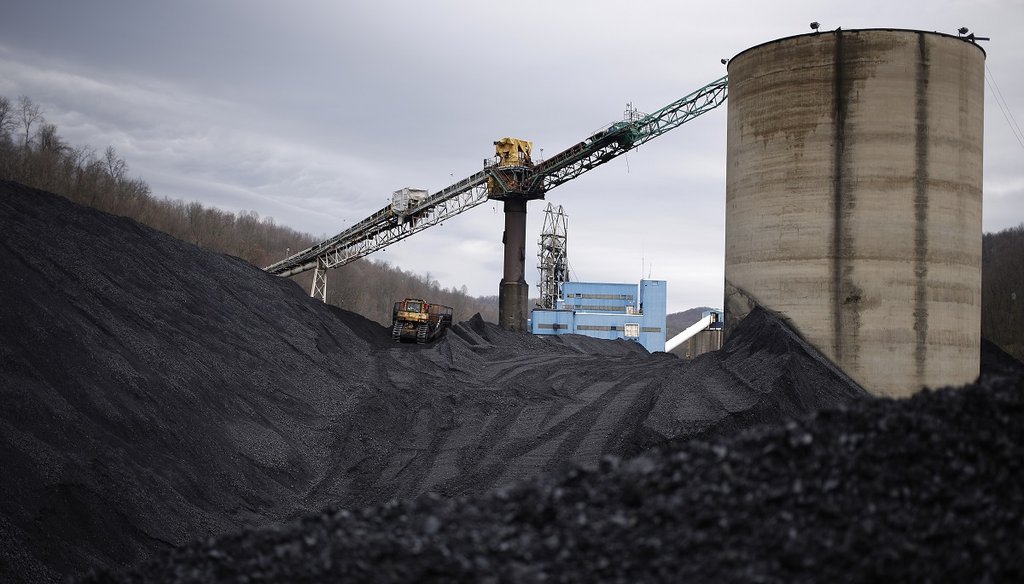Stand up for the facts!
Our only agenda is to publish the truth so you can be an informed participant in democracy.
We need your help.
I would like to contribute
Upticks in manufacturing employment, little policy progress

Mounds of unsold coal near Fairview, W.Va., April 11, 2016. The $1.5 trillion tax bill barreling toward President Donald Trump's desk is overwhelmingly a big win for corporations, but not every business benefits equally. (Luke Sharrett/The New York Times)
President Donald Trump promised to revive manufacturing on the campaign trail. One year in, the industry is on the same trajectory as when he took office.
"My plan includes a pledge to restore manufacturing in the United States," Trump said in a campaign rally in Detroit, Mich., on Oct. 31, 2016.
Bureau of Labor Statistics data shows that jobs have been on a slight uptick. Between November 2016 and November 2017, the number of manufacturing jobs rose by 189,000.
But the growth reflects a continuation of the trends former President Barack Obama's fiscal and monetary policies set in motion, experts told us.
Robert Scott, director of trade and manufacturing policy research at the left-leaning Economic Policy Institute, likened patterns in manufacturing industry to an aircraft carrier.
"It is very hard to move," Scott said. "Once you get it going it's hard to slow down and once it's stopped it's hard to get it moving again."
Source: Bureau of Labor Statistics
"Manufacturing has dropped by about 30 percent since the 2000s," said Susan Houseman, vice president and research director at the Upjohn Institute for Employment Research. "It's ticked back up in recent years but hasn't even come close to regaining employment levels before the recession. So you have to paint a picture of manufacturing that's very weak still."
Economists attributed the harsh drop since 2000 to several factors: decreased domestic demand, the automation of manufacturing processes and drops in exports relative to imports, also known as the trade deficit. The latter was a frequent target of Trump's stump speeches, but experts say he's done little to address it.
"The goods trade deficit has increased 7.3 percent this year relative to the same period in 2016, reflecting the complete failure of the Trump administration to take any significant action to reduce the growth of this deficit," Scott said.
The North American Free Trade Agreement -- which Trump promised to renegotiate -- is not nearly as problematic as the trade imbalance with more powerful countries like China, Japan and Germany, according to Scott.
Trump broke his promise to declare China a currency manipulator in April, although his new National Security Strategy declares "the United States will no longer turn a blind eye to violations, cheating or economic aggression."
That stance has yet to materialize in specific trade policies. And there has been no public updates on the investigations Trump directed into unfair steel trade practices or China's alleged intellectual property theft.
Soon after taking office, Trump created the Manufacturing Jobs Initiative, a council comprised of 24 chief executives, but he disbanded it with a tweet after several members resigned following Trump's response to Charlottesville in August.
The most concrete accomplishment in reinvigorating manufacturing, then, comes in the form of business optimism.
"I do not believe he has done a lot to change the position of U.S. manufacturing, but he has imbued a strong sense of optimism in the business sector that encourages investment," said Martin Baily, a senior fellow in economic studies at Brookings. "Lowering the corporate tax rate will bring foreign investment into the United States."
The National Association of Manufacturers reported record-high confidence levels in a survey that Trump tweeted.
Bradford DeLong, an economics professor at U.C. Berkeley, said new tax legislation may have the opposite effect. By incentivizing investment, DeLong argues, the tax bill funnels away money foreigners may have otherwise spent on domestically manufactured goods.
"It's not going to be as large a shock as was delivered to the manufacturing sector by the 1981 or the 2001 and 2003 cuts in taxes," DeLong said. "But it is very likely to be the big factor driving the change in the manufacturing employment share over the next two years. And it is likely to drive it down."
Trump has been taking small steps to improve U.S. standing in trade relations and has improved confidence in the manufacturing industry, but he's got a long way to go to reach the level of output enjoyed before 2000.
We rate his promise In the Works.
Our Sources
Phone interview with Robert Scott, director of trade and manufacturing policy research at the Economic Policy Institute, Dec. 15, 2017
Phone interview with Susan Houseman, vice president and research director at the Upjohn Institute for Employment Research, Dec. 15, 2017
Email interview with Martin Baily, senior fellow in economic studies at Brookings, Dec. 15, 2017
Email interview with Brad Delong, University of California, Berkeley economics professor, Dec. 15, 2017
Email interview with Steven Cheung, White House spokesman, Dec. 8, 2017
PolitiFact, Trump on China: 'They're not currency manipulators', April 13, 2016
WhiteHouse.gov, National Security Strategy, Dec. 18, 2017
BLS.gov, The employment situation: November 2017, Dec. 8, 2017
Data.BLS.gov, Manufacturing Employment, Seasonally Adjusted, accessed Dec. 18, 2017
Financial Times, Trump to accuse China of 'economic aggression', Dec. 15, 2017
New York Times, Nafta Round Closes With Talks Bogged Down by Conflict, Nov. 12, 2017
